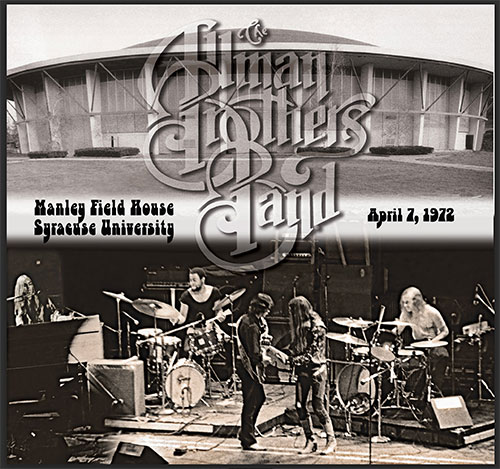
Five months after Duane Allman was killed in an October 1971 motorcycle accident, the five-member Allman Brothers Band performed a blazing rock ‘n’ roll show in a dirt-floor field house in Syracuse, New York.
The entire concert was released in January as a two-CD set, Manley Field House, Syracuse University, April 7, 1972. It was a rare show as dirt and dust kicked up by concertgoers hung in the air, because the five original members only played together during a brief period. Keyboardist Chuck Leavell joined the band six months later, and bassist Berry Oakley, whose bass is prominent throughout the Syracuse show, died in a motorcycle crash in November 1972.
“The guys were dealing with the devastating loss of Duane — on both a personal and musical level,” John Lynskey, the band’s historian who wrote the liner notes on 25 Allman Brothers albums, tells me. “Dickey Betts took on the challenge of being the only guitarist in what had been a formidable dual guitar lineup, and he answered the call, with tremendous assistance from bassist Berry Oakley. All the guys worked together to fill that enormous void, and you can hear them succeed on Manley Field House.”

Many Allman Brothers collectors have heard a bootleg version of the concert that was sourced from a radio broadcast. The new album sounds light-years better, and the executive producer, Bert Holman, who has been the band’s manager since 1991, explains why.
“We were able to source the original recording tape, transfer it to digital files, restore the files removing hiss and other degradations and EQ the tracks for better sonic reproduction,” he says.
In the album’s liner notes, Jeff Chard, Syracuse University’s concert coordinator in 1971-72, raves about the concert and the band’s ability to carry on after the loss of slide guitarist Duane Allman.
“The quintet (which also included Gregg Allman on keyboards and vocals and drummers Butch Trucks and Jai Johanny “Jaimoe” Johanson) had pushed on, playing some 41 shows in 22 weeks,” Chard writes. “This night saw Gregg singing and playing his heart out, while Dickey Betts is doing phenomenal double duty on guitar, switching seamlessly between the necessary slide parts and his own soaring leads. But the real revelation of the night is that Berry is the glue, and the second lead player as well. His thunderous bass holds the quintet together — you’ll hear it, and we could see it that night. Then there is the way Butch Trucks and Jaimoe lock in on the drums, the way the whole unit responds, five playing as one.”
Eleven songs were played at the 95-minute concert, beginning with “Statesboro Blues.” Memorable versions of “In Memory of Elizabeth Reed” and “Whipping Post” follow, as well as an early live version of “Ain’t Wastin’ Time No More,” which then had just been released on the group’s Eat a Peach album. Another song entitled “Syracuse Jam” catches the band jamming and hasn’t appeared on any previous Allman Brothers Band recording.
Holman holds the Syracuse show in high regard but points to the Allman Brothers concert at New York City’s Fillmore East on June 26, 1971, as the best one he has heard. That show was not recorded and was the final concert in front of a paying audience at the legendary venue.
“The band was on fire and playing with intense emotion,” says Holman, who cites a Thanksgiving 1969 Rolling Stones concert at Madison Square Garden as “an epiphany” that made him decide to work in the music business.
His second-favorite show was in New York’s Carnegie Hall in November 1971 — “a very poignant show without Duane,” he says.
He also cites the band’s show at New York’s Beacon Theatre on October 28, 2014. It was the final show at the Beacon, where the band annually played multiple shows.
“Nothing was left on stage,” Holman says. “They played their hearts out.”
I ask Holman why the Allman Brothers Band was so beloved by the group’s fans.
“The Allman Brothers Band were always about the music first,” Holman says. “Every night was an experience and never the same approach to the music. The committed fans discovered this and joined on the road that goes on forever.”
Lynskey, who was editor-in-chief of the Allman Brothers fanzine Hittin’ the Note 1995-2014, has attended “several hundred” of the band’s concerts. He says a July 1976 concert by the Who at a Miami baseball stadium when he was 16 was “a game-changer” in his life.
I ask him, though, why he was drawn to the music of the Allman Brothers Band more than the music of other artists.
“The passion, the intensity and improvisational genius of the original Allman Brothers Band lineup was unlike anything else I’ve ever heard,” Lynskey says. “They were a group like no other.”
